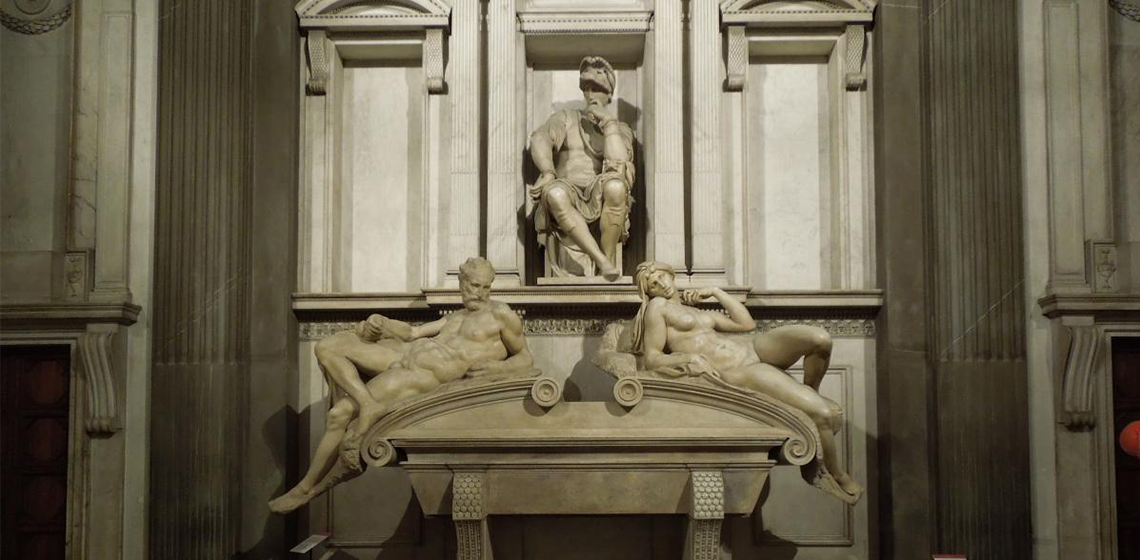
Journey to the center of Medici splendour
The place that more than any other represents the magnificence of the family that governed the city of Florence for centuries: the Medici Chapels.
There are places where it’s as if time stretches on for eternity, where the minutes, hours, days and years don’t seem to have their usual effect, overpowered and imprisoned by eternal beauty.
It’s a bit like those films where the characters go on interstellar journeys and are able to move through different time dimensions, free from past and future: in Florence, there’s a place where time seems to stand still, almost powerless, governed by the space itself.
A suspended place
The beautiful thing is that you don’t need to climb aboard a spaceship to reach it, just go to piazza Madonna degli Aldobrandini, n° 6 to cross the threshold. What awaits you beyond the door isn’t a parallel universe, but seems in every way like another world (in reality, it kind of is): you’re on the “planet” of the Medici.
The Medici Chapels are the mausoleum of the Medici and it is here that you will find the tombs of the most famous members of the family that for centuries marked the history of art, including Lorenzo the Magnificent and his brother Giuliano (victim of the famous Pazzi Conspiracy), as well as the great Cosimo I and his son Francesco I.
After the ticket office is the crypt: a vast space covered with vaults supported by strong pillars, an austere place but with an evocative atmosphere, and from here, you’ll be launched into a centuries-long history of the family. Without even realizing it, you’ve already begun your journey back in time.
The Chapel of the Princes
Heading up the staircase to the right, you’ll come to the Chapel of the Princes, an extraordinarily beautiful octagonal mausoleum, a symbol of wealth and self-glorification of the family.
Conceived of by Cosimo I, its construction began under Ferdinando I. In order to build it, rare headstone materials and semi-precious stones were collected from around the world and worked at the Opificio delle Pietre Dure, which still today is a leading institution in restoration. This was 1588. Incredible, right?
The setting is a triumph of materials and colours, not to mention a determined attempt to amaze visitors with its magnificence, and we can say that the attempt was quite successful. Just think that it took centuries to decorate the chapel and that it was Anna Maria Luisa de’ Medici, the last heir to the dynasty that would die with her, who finished the chapel and gave to history the last great work commissioned by the Medici patrons.
The New Sacristy
Continuing down a corridor that leads from just across from the entrance, you will reach the New Sacristy (called so to distinguish it from Brunelleschi’s Old Sacristy); here, you will find yourself face to face with one of Michelangelo’s strongest works, as well as an early example of Mannerist architecture.
You can admire statuary groups made by the Master, which are not just works of extraordinary beauty, but are one of his greatest sculptural achievements.
The theme of the dome is “time that passes” and consumes everything (but upon which the Medici family symbolically imposed their superiority) and the sculptural complex is a reflection of this: the funerary monuments placed at the two sides of the chapel, on top of the tombs at the feet of the dukes, represent the Allegories of Time: Day and Night on the tomb of Giuliano de’ Medici and Dusk and Dawn for Lorenzo.
Information
Full price € 8,00
Reduced price € 4,00
Hours: every day, including holidays, 8.15 am to 5pm
Closed on the first, third and fifth Monday of the month and the second and fourth Sunday.
The last entrance is 40 minutes before closing, at 4.20pm.






 All the services are provided by local merchants
All the services are provided by local merchants By using this site you support Florence
By using this site you support Florence We offer products with high-quality standards
We offer products with high-quality standards You stay sustainable
You stay sustainable It's a 100% trustworthy website
It's a 100% trustworthy website